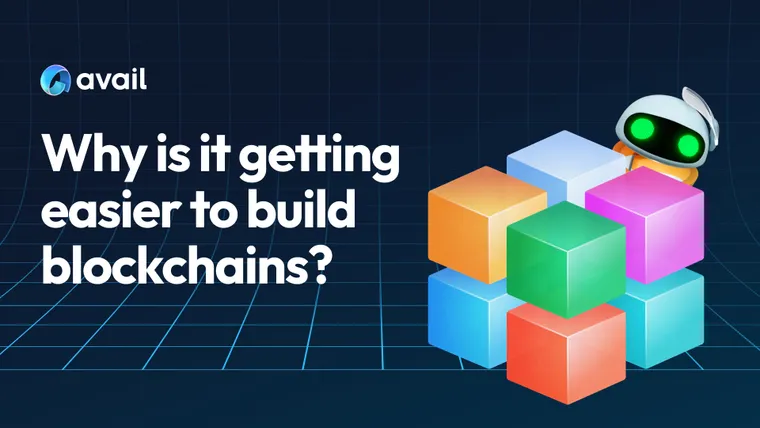It’s now more accessible than ever to build a blockchain, yet many developers still don’t know of the opportunities that are available. This change has primarily been brought about by the introduction of more flexible and customizable modular blockchain architectures. The barriers to building a blockchain are significantly lower, the tools are in place and many opportunities are still yet to be explored.
In this post we look at the fundamentals driving down the barriers to building a blockchain in 2024, and discuss why today might be a good time to start working on that blockchain project you’ve always dreamed of.
Then vs Now - What’s changed?
To gain some context, developers building in the blockchain space previously had two main options. Deploy a smart contract on a general purpose blockchain like Ethereum or build an entirely new blockchain. While deploying a smart contract was relatively easy, transaction fees were unpredictable, wrecking some use cases when fees surged.
Building a blockchain by contrast brought greater flexibility but at a significantly higher development cost. Building a new blockchain was a time consuming and expensive process, often reserved for those with access to significant capital. Some blockchain networks began to make this easier, such as Cosmos with the Cosmos SDK, Polkadot with Parachains and Avalanche with Subnets. However, the breakthrough in adoption really came with the introduction of rollups on Ethereum.
Developers today have a new and far more viable option, which in some ways can be thought of as a mix between the two. A lot of the flexibility that comes with building a custom blockchain can now be achieved without the expensive overhead of maintaining a new, decentralized network. There’s no need to recruit and incentivise validators to secure your chain, making the go-to-market a lot cheaper and faster. You also have the benefit of selecting from a growing number of infrastructure providers tailored to meet your needs. Once you’re ready, you can simply just deploy your new blockchain into an existing decentralized network.
Here’s a quick look at the fundamentals contributing to this new era in blockchain development.
1. Higher Throughput
Separating transaction execution has essentially solved blockchain throughput limitations. Purpose built execution environments can individually process transactions and roll them up into batches for settlement in bulk.
This is having a meaningful impact on the Ethereum ecosystem. The below graph shows a ~30X improvement as compared with Ethereum’s throughput over a 30 day period. It’s worth highlighting that this is just the improvement recorded in actual transactions. The theoretical increase in throughput is much higher.
Image source: https://l2beat.com/scaling/activity
2. Blockchains are Cheaper to Build
In the past, an individual or small team of developers would have found it quite difficult to deploy a brand new blockchain into production. Not only would they be required to develop the core protocol, but they would also need to set up, incentivise and maintain a distributed network of validators (or miners) to keep the network alive.
All of this takes time, effort and resources away from building software that is valuable to end users. A small team could have collaborated on a small project and deployed a smart contract relatively cheaply and easily. However, this convenience and affordability would come with some limitations in developer flexibility.
Today, an independent or small team of developers can easily build and deploy a blockchain into production. They now have access to a number of purpose-built blockchain components (see point 4 below), that can be combined with others to build a blockchain. This in conjunction with the ability to tap into and build on existing blockchain networks (see point 5 below) is a major breakthrough. There’s no need to set up, incentivize and maintain a decentralized network, you can simply pay a small transaction fee for usage of a network. This is more similar to how modern web2 applications are developed and allows more time to experiment and commit resources to solving the primary use case.
3. Blockchains are Cheaper to Use
These efficiencies are being passed through to users in the form of lower transaction fees. As can be seen by the graph below, most L2 users are now paying less than 10 cents per transaction.
Image source: https://dune.com/Marcov/layer-2-transaction-cost
On-going development is helping reduce these costs even further. Validiums and Optimiums are both blockchain designs that publish transaction data to a purpose-built data availability solution, making blockchain transactions even more affordable. Some teams are also experimenting with sponsored gas fees, a model which subsidizes transaction costs for end users making their onboarding process as cheap and frictionless as possible.
4. More Customization
Now developers have a whole range of options to choose from when building a blockchain. This includes different languages, execution environments, virtual machines and more. The infrastructure available is evolving rapidly with more and more projects being released into the market.
Image source: Victor.crypto
Customization is not just limited to the tech stack selected, but the design of the blockchain’s architecture too. Rollups, Validiums, Optimiums, BTC L2s and Sovereign Rollups all provide slightly different characteristics to developers and end users, providing a range of options to experiment with.
If all this choice feels overwhelming, a new category of Rollup-as-a-Service providers have emerged to reduce the complexity and provide you with an easy and streamlined developer experience.
5. Inheriting Security
In the past, blockchain developers were required to attract crypto-economic security to the network every time they built a new blockchain. This would involve launching a token, accruing value to the token and then encouraging validators or miners to secure the chain in return for token rewards. Now anyone can simply deploy a rollup on a base-layer blockchain and inherit its security.
The market for crypto-economic security is maturing with initiatives like re-staking and multi-asset shared security.
Crypto-graphic security is also advancing and helping blockchain networks become more secure. Validity proofs and fraud proofs provide a scalable way to quickly and cheaply verify events within decentralized networks.
While developers can by no means abandon security practices altogether when building a blockchain, they are no longer required to establish and maintain the security of an entire network.
6. Promising Growth
This evolution of blockchain development is gaining traction. Various sectors including DeFi, NFTs and on-chain gaming have contributed towards steady growth. Users are attracted by low transaction fees and many developers are leveraging all of the benefits and simplicity of deploying a modern blockchain.
Image source: https://l2beat.com/scaling/summary
Teams that have historically run their own blockchains are also migrating, or starting to experiment with these new types of networks. Some of the benefits cited include reducing infrastructure and operational costs, maintaining or introducing better compatibility with the Ethereum ecosystem, ensuring adequate decentralization of the network and improved network effects.
7. More viable use cases
Now that blockchain applications can carve out dedicated execution space, the number of viable use cases has gone up. Use cases which relied on low transaction fees to survive can keep transaction fees low. Even if there are large fluctuations in the price of ETH, your app can continue operating as normal, meaning you don’t have to pass on higher gas fees to users.
There’s much more freedom when it comes to the execution environment a blockchain can adopt. If the EVM doesn’t support, or is not well suited to a particular use case, it’s easy to use something else. Then it’s just a matter of deploying it into an existing network and inheriting the network’s crypto-economic security. All of this freedom and flexibility is likely to lead to much faster iteration cycles as teams look for product-market fit.
The technology risk of building with a blockchain today is significantly lower than it has ever been, and some use cases are now gaining traction even though they had been first experimented with many years ago. Polymarket is a recent example. Despite teams like Gnosis and Augur having built on-chain prediction markets previously, neither achieved the level of adoption being experienced by Polymarket today. Web3 gaming is another example where applications are attracting a large user base, expanding beyond a crypto native audience.
Where to from here?
While all of these factors combine to make blockchains significantly more attractive for application developers and users alike, key challenges still remain. One of the most notable is the long-standing challenge around cross-chain fragmentation. Interoperability between these new chains is still a challenge, but one the Avail team is excited about solving.
If you’re interested in building a blockchain on a modern tech stack today, check out this getting started guide or visit the awesome-avail github repo for a curated list of resources.


